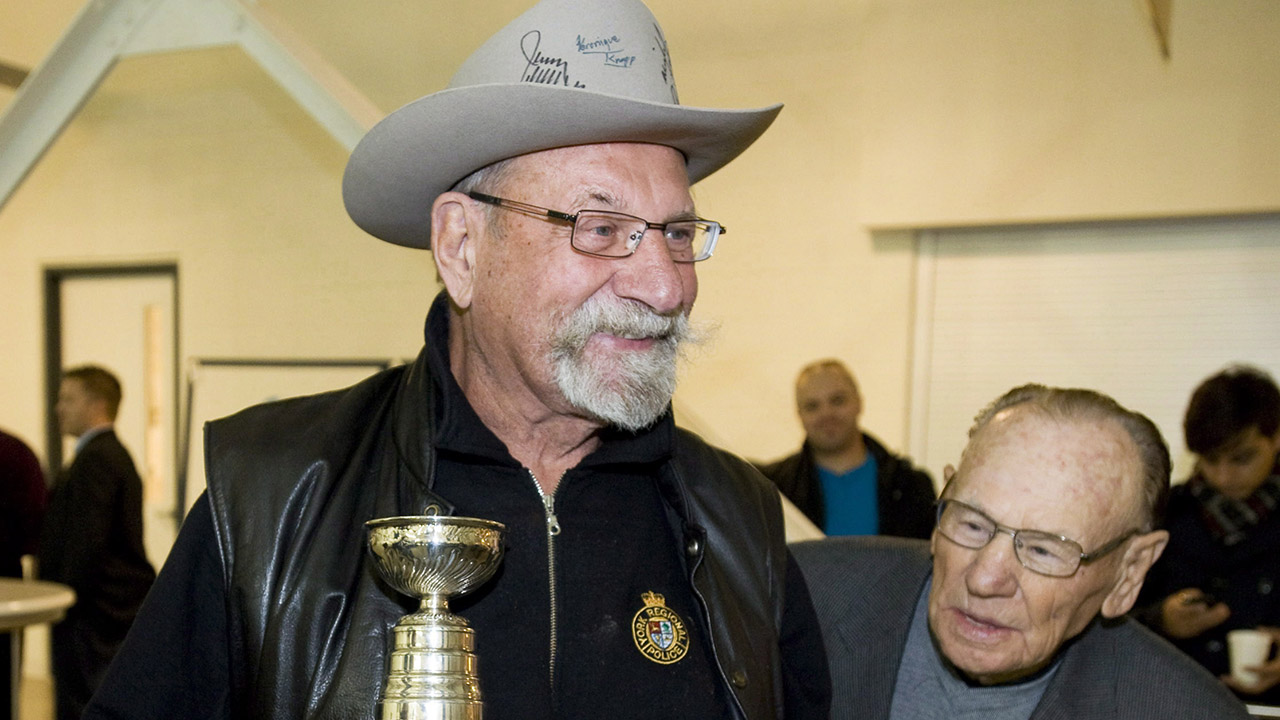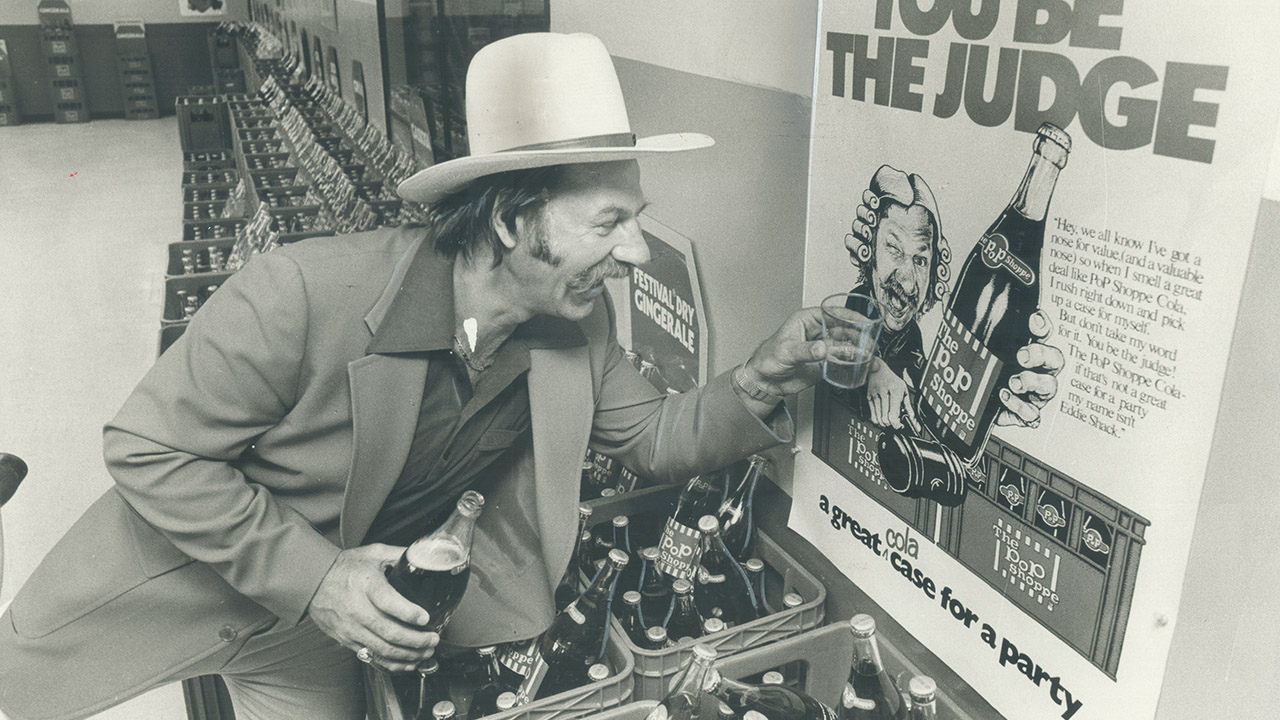
Many better hockey players are not so well known or beloved as Eddie Shack. Many logged long careers without a nickname ever sticking, but Shack had a couple: ‘Eddie the Entertainer’ and ‘The Nose,’ the former a testament to his playing style, the latter to his full facial rudder. And even Hall of Famers aren’t celebrated in song as Shack was: In February 1966, “Clear the Track, Here Comes Shack” landed at the top of the CHUM Charts, the flagship radio station’s ranking of record sales in the Toronto market. The single managed to beat out songs by, among others, The Beatles and The Rolling Stones.
With his death Sunday morning at the age of 83, it’s with longing and laughter that fans of a certain vintage will remember him. To say they don’t make players like him anymore captures half of it. Fact is, even back then they made only one.
Shack defied easy categorization. He wasn’t an enforcer per se, although he could and would frequently drop the gloves. (Per Hockey Fights, there were 37 bouts in his 17-year career, although it’s hard to believe there weren’t at least that many more.)
Shack was too formidable to be a pest, not one to instigate and leave the clean-up to others. He might look terrified when staring at John Ferguson, his counterpart and nemesis in Montreal, but he didn’t duck and run.
Shack wasn’t unskilled. True, the puck tended to die on his stick, but he ranked as one of the league’s fastest players. Think of a runaway train on a downhill grade.
Shack also wasn’t particularly coachable — it’s safe to say no amount of Xs and Os or chalk talks would have had any impact on his mayhem-making on the ice. Yet when his former coach in Toronto, Punch Imlach, took over in Buffalo in 1970, he went out and traded for Shack, then past his peak.
“My old friend Eddie had been pretty good for me over the years, despite the battles we had,” Imlach wrote in his autobiography, Heaven and Hell in the NHL. “In Toronto I once traded him to Boston for Murray Oliver and $100,000, but no one could ever put a price on the laughs he gave us in Buffalo.”
As idiosyncratic and fun-loving as he was, his reputation as a clown poorly served him. He wasn’t a passenger — as a player he was underrated, probably inevitably so. He was a significant contributor to four Stanley Cup teams in Toronto, even scoring the goal that clinched the Cup in ’63. In 1965–66, his best season with the Leafs, he scored 26 goals when such totals were hard to come by.
In the early expansion era, he bounced around the league and wound up scoring 20 goals in a season with five other teams, tying what was then the league’s record. As George Armstrong, the last Toronto captain to raise the Stanley Cup, told the Sault Star a few years back: “He was a damn good hockey player and he was tougher than nails,” he said. “When he got out there, you had to look out, ’cause you never knew what could happen. Our own team had to look out, because you never knew what he’d do.”
Off the ice, Shack was decades ahead of his time. No one did more to monetize his celebrity. While many players of that era wound up on hard times, Shack prospered. He had no formal business training — he dropped out of school early and was functionally illiterate until later in life. No matter — there’d be nothing for him to learn from in Harvard’s MBA program. He had a remarkable talent, wholly intuitive, when it came to calculating his price point.
One well-known anecdote that made the rounds was instructive.
During his days with the Maple Leafs, Shack was flooded with offers from Toronto businesses to make promotional appearances. One time, he agreed to do a meet-and-greet or ribbon-cutting or some-such at a car dealership: for a couple of hours of his time and a stack of autographs he stood to make $1,000. Payable in $50 bills, per his request. When the day arrived, so did a famous Leaf, albeit not Shack. (No other names will appear here to protect the truly innocent.) The dealership’s manager called Shack at home and asked him what was going on. Shack told him that he had a conflict (that is, a better offer) and that his teammate had agreed to appear for $500. Seeing his glass as half full, the manager sighed and said, “Well, at least it saves me $500.” The glass was then emptied by Shack. He told the manager that in fact he’d come by later to collect the balance — that his finder’s fee for landing the player was $500. Which would be a great story if it ended there … but it didn’t.
Shack’s stand-in at the event happily went through the drill of handshakes, autographs and posing for photos with found-ins. At the end of the day, the manager peeled off 10 crisp $50s, which the player counted. He then put nine in his wallet and one in his breast pocket. Giving it a tap, he told the manager: “A little something for Eddie.”
For all his abilities in the area of personal wealth accumulation, though, Shack did invest himself in good causes beyond mammon — after he learned to read, he became an advocate for literacy.

I had only a couple of dealings with him over the years — the last in November when I had the unenviable pleasure of following him at a book signing.
For our first meeting back in the early ’80s, I was a journalism student signed up for a course in writing about business, a subject that I had no grounding in whatsoever. I wound up drawing an assignment writing about Pop Shoppe, a Toronto-based soft-drink bottling company that was struggling mightily at the time.
The generation that grew up in the late ’70s might not have ever seen Shack play, but knew him because of his appearances in Pop Shoppe commercials. He wasn’t simply a pitchman or endorser. Effectively he was the whole brand — its most significant asset.
I don’t know what television viewers made of a guy whose moustache was less handlebar than crowbar, whose cowboy hat would have been strictly a Halloween accoutrement in his hometown of Sudbury. But when Pop Shoppe was ever mentioned, his image came to mind and so did the tagline: “I’ve got a nose for value.” This was a rare case of truth in advertising.
When I asked Shack about Pop Shoppe, he was at once light-hearted and clear-eyed.
“I’ve always recognized a good deal, and Pop Shoppe’s a good deal,” he told me.
It wasn’t altogether clear to me whether he was saying the product was a good deal or his position with the company or both.
When I asked him about the company’s struggles, he didn’t miss a beat.
“Everything I know about business I picked up on the way,” he told me. “I know the value of a buck. I worked in a butcher’s after I dropped out [of school]. I had jobs all the time I was playing with the Leafs — everybody did ’cause we had to. I’ll always be looking out for a good thing.”
It wasn’t a case of everything else he touched turning to gold, either — for instance, a chain of doughnut stores didn’t take off like the one founded by his Toronto teammate, Tim Horton.
Another business opportunity that seemed to fall through the cracks was, in fact, “Clear the Track, Here Comes Shack.” The song was written by Brian MacFarlane, studio host of Hockey Night in Canada, who, in fact, couldn’t read music. The single was hastily recorded and expected to be no more than a novelty 45, instead of a chart-topping song. Shack was long upset with MacFarlane because he never received any fee for the use of his name or any royalties. Fact is, MacFarlane didn’t see a dime from it either.
Eddie Shack knew the value of a buck, but may not have grasped how much the song contributed to his persona. With his passing, it will be played with fond memories, whether you knew him as a player, pitchman or the life of the party.




